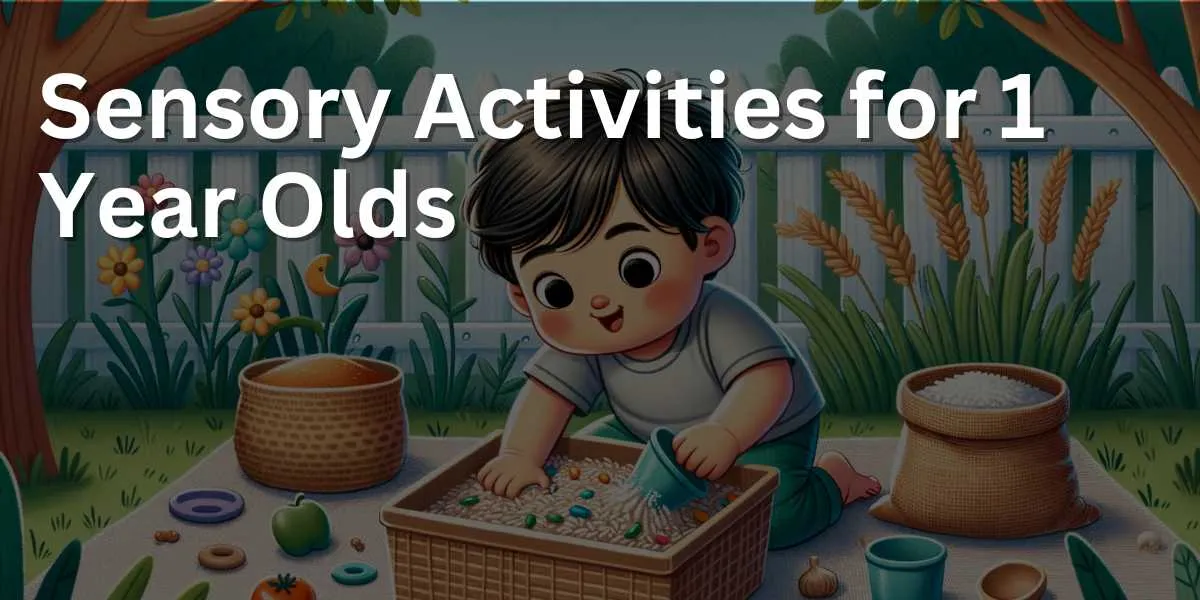Venturing into sensory activities for 1 Year Olds can be a delightful and enriching journey. At this age, sensory play is paramount in stimulating young minds, fostering curiosity, and aiding neural connections.
Designed specifically for the delicate and explorative nature of 1-year-olds, these activities aim to captivate their budding senses. From feeling various textures to experiencing new sounds and colors, these activities not only captivate but also pave the way for essential developmental progress. This guide will present a curated list of sensory activities ideal for 1-year-olds, elucidating their benefits and simple ways to integrate them into daily play.
Ready to spark joy and discovery in your little one’s life? Dive into our handpicked sensory activities tailored for the vibrant world of 1-year-olds.
Touch and Texture Sensory Activities for 1 Year Olds:
Texture Boards: Create boards with various materials like felt, sandpaper, cotton, and silk for the child to touch and explore.
Rice and Bean Bins: Fill a shallow container with rice or beans. Add cups, spoons, and small toys for scooping and pouring.
Sock Puppets
Making sock puppets is one of the many DIY sensory activities for 1 year olds. It provides children with a tactile sensory experience as they handle the materials and promote ingenuity and fantasy as they create their puppet characters and tales.
And all you need is a few old socks and some craft bits from sensory bags! This exercise can foster language development as children use puppets to converse and interact with others. Creating dolls with various textures and materials, such as felt or yarn, can provide extra tactile sensory experiences.
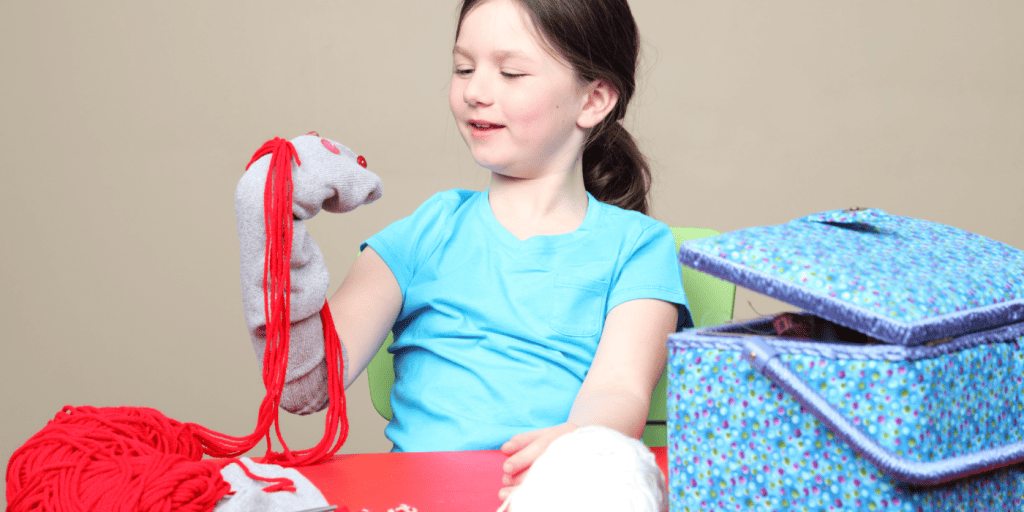
Rice Play
As children handle the substance, playing with rice can provide a soothing sensory experience while improving fine motor skills. This exercise can foster ingenuity and imagination as children construct designs and patterns with the rice. Adding small toys or objects to the rice can turn it into a scavenger hunt for children to explore and discover. A simple but very fun activity.
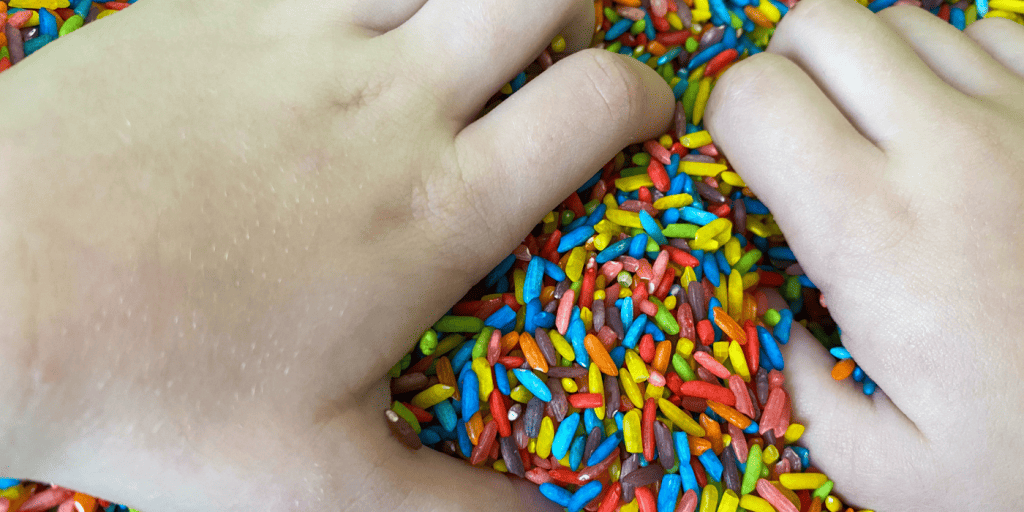
What’s In The Box
Placing various items in a box and asking children to predict what’s inside can provide an enjoyable tactile sensory experience while encouraging language development as children explain the objects and make estimates.
As children manipulate the items in the box, this exercise can also help them build fine motor skills. Using various shaped and sized receptacles, such as tiny boxes or bags, can increase the degree of astonishment and challenge in the activity. You can also add in foil, bubble wrap, a tissue box and more.
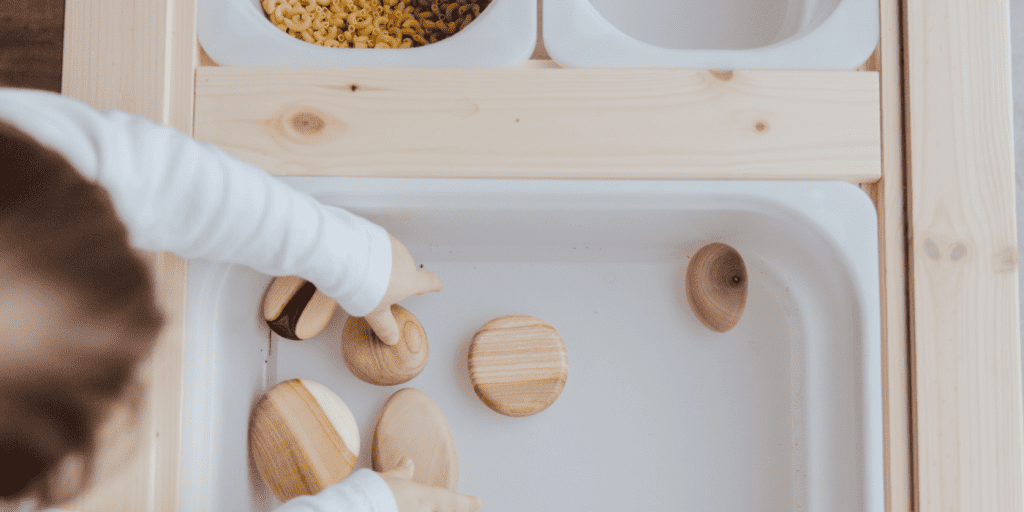
Sensory bin
Fill a container with different materials for your child to explore, such as rice, beans, or sand. Bury small toys or objects in the bin for them to find. Let them pour and scoop the materials. Supervise closely if your child still puts things in their mouth.
Sensory touch and feel box
Fill a box with objects of various textures for your child to touch and explore, such as cotton balls, sandpaper, pinecones, shells, etc. Rotate items to keep it interesting. Handle items together and describe how they feel.
Messy Play Sensory Activities for 1 Year Olds:
Mess-Free Painting
One of the activities to do with one-year olds is mess-free painting. Painting is a wonderful visual experience, but the debris can be overpowering. Using a sealed plastic bag or drawing with water on a blackboard can provide the same sensory experience without the cleaning.
As children explore various hues and patterns, this exercise can also help them develop their creativity and imagination. Including various materials in the artwork, such as cotton balls or bubble paper, can add to the visual experience.
Jelly Exploration:
Set gelatin in a tray and let the child squish and explore its wobbly texture. Digging for jello can provide an enjoyable and distinct sensory experience for children who enjoy investigating various materials. This exercise can help children improve their fine motor skills as they explore with utensils or their fingertips, as well as their language development as they explain the texture and color of the gelatin.
Adding tiny toys or items to the jello allows children to play an enjoyable and difficult game of finding and exploring.
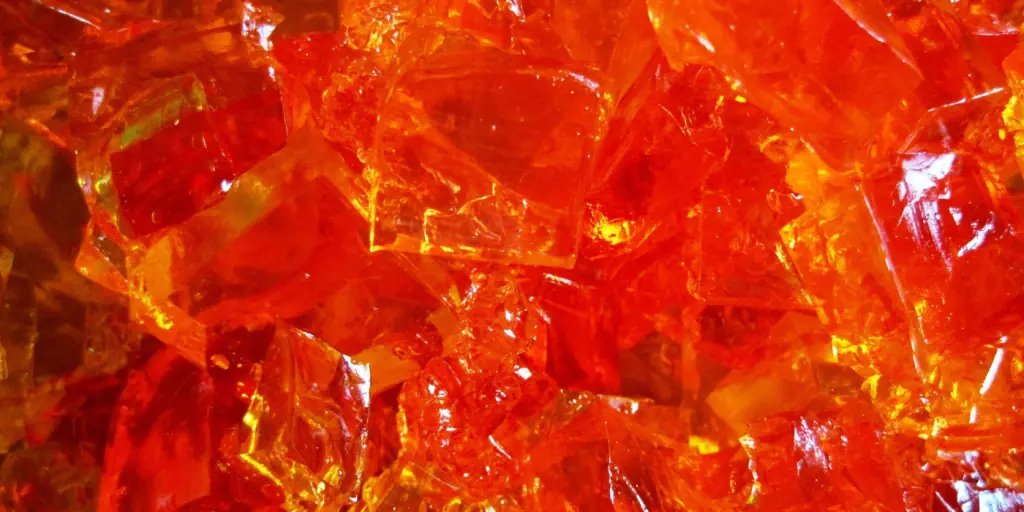
Cornmeal Sand Doodle with Food Coloring
When cornmeal and sand are combined, they form a distinct sensory substance that children can use to create patterns and sketches. This exercise can help children develop fine motor skills while encouraging ingenuity and imagination as they explore various designs.
Food coloring can be added to the cornmeal and sand combination- and to many sensory play activities- to make a more aesthetically exciting and colorful sensory substance.
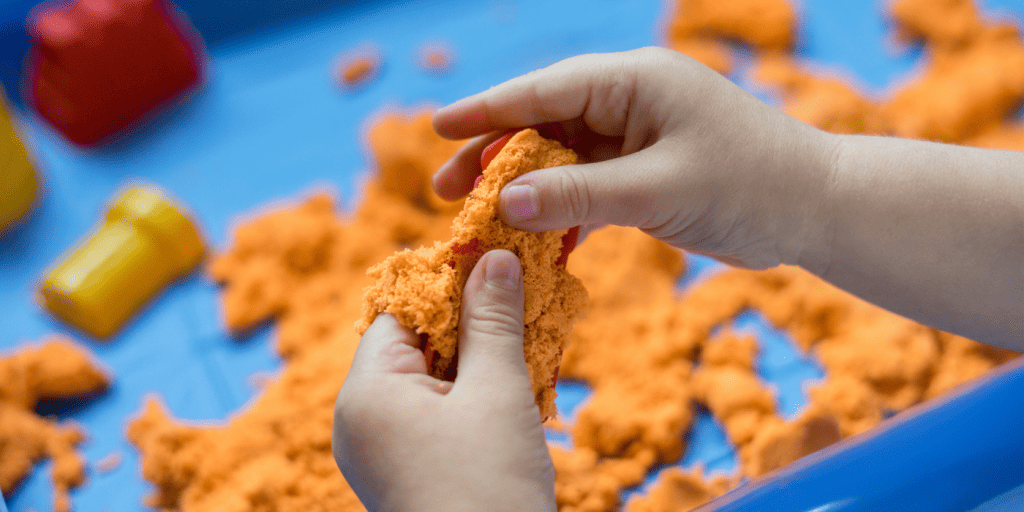
Non-Newtonian Fluid Play
By combining ingredients like cornstarch and water, you can make a sensory substance that changes consistency based on how it is handled. This exercise can provide a stimulating sensory experience while encouraging fine motor skills and science inquiry.
Experimenting with different cornstarch and water ratios can produce various consistencies and textures for children to explore. Old leftover plastic easter eggs can be handy for this, as well as pouring or using as paint trays.
Playdough
Make some homemade playdough and let your child mold it into different shapes. Show them how to roll, pinch, and flatten the dough. Add cookie cutters to make shapes. Let them explore the squishy texture.
Sensory balloons
Fill balloons with different materials, such as rice, flour, or small toys. Tie them closed securely. Let your child squish and play with them, exploring the textures inside. The stretchy plastic is also interesting.
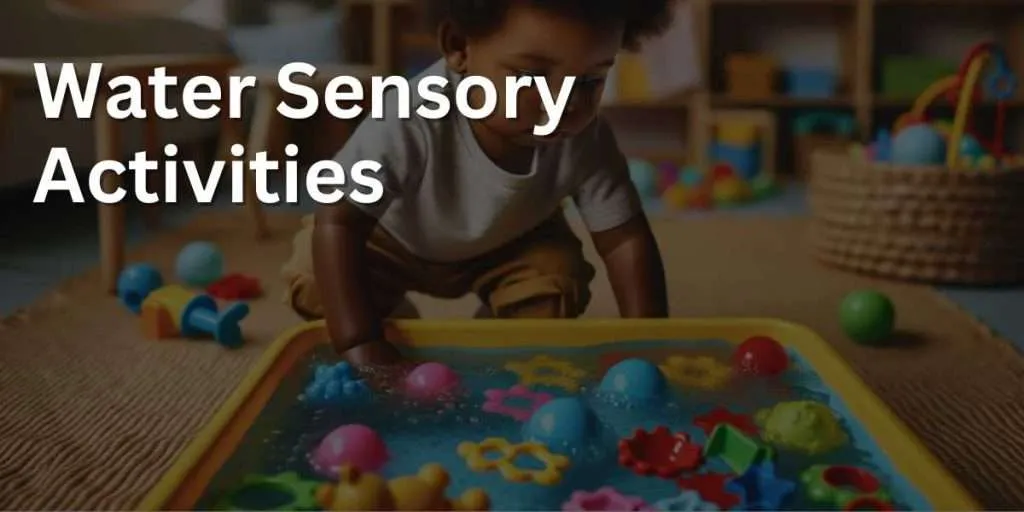
Water Play Sensory Activities for 1 Year Olds:
Water Transfer:
Provide two bowls, one filled with water and one empty, along with a sponge or cup. Encourage transferring water from one bowl to the other.
Floating and Sinking:
Offer various objects to see which ones float and which ones sink.
Water play
Fill a container with water and let your child splash around. Add some cups, funnels, and toys for pouring and scooping. Bubbles make water play even more engaging. Supervise closely, especially with infants. Have towels ready for clean up!
Ice cube play
Freeze some colored water in ice cube trays and let your child play with them as they melt. Place them in a shallow bin or tray to contain any water. The cold sensation is soothing on gums for teething babies.
Auditory Activities Sensory Activities for 1 Year Olds:
Homemade Music Shakers:
Fill containers with different items (rice, beans, bells) and let the child shake and listen to the sounds.
Nature Sounds:
Take them outside to listen to birds, rustling leaves, or the wind.
Bottle Shaker
Making a bottle shaker out of rice or legumes can provide an enjoyable sensory experience while helping children with fine motor skills as they grasp and jiggle the container. This exercise can also help children improve their speaking skills as they explain the sound and action of the shaker.
Using stickers or paint to decorate the outside of the container can add creativity and personalization to the exercise. Sensory bottles are an excellent, cheap way to create a few toys for your child.
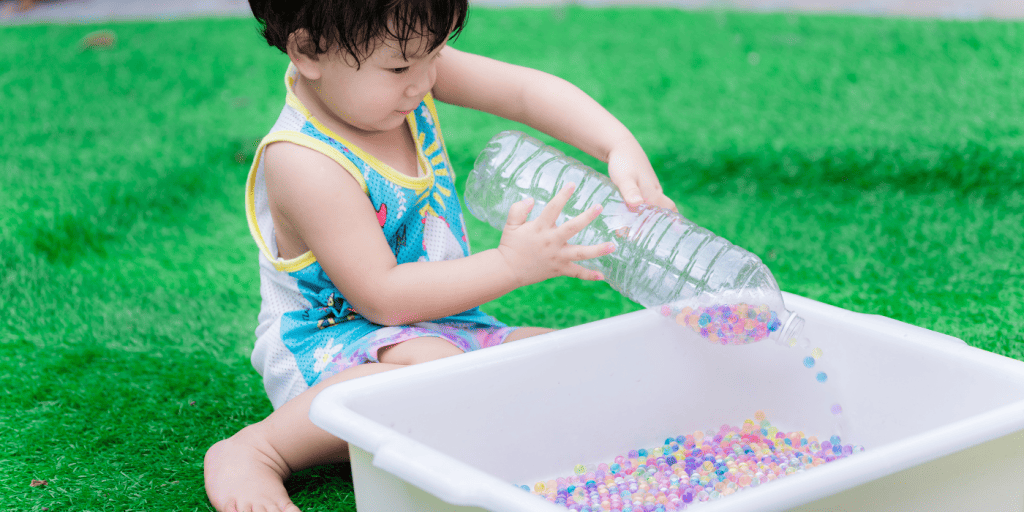
Baby Music Instruments
Simple melodic devices, such as chimes or shakers, can promote sensory discovery and the development of fine motor skills as children handle them.
This exercise can foster social and emotional growth as children learn to take turns and play together. A simple cardboard paper towel roll can be useful for this, along with dried peas or grains of rice.
Jingle bell play
Give your child some jingle bells to play with to stimulate their sense of hearing. Let them shake the bells gently to explore cause and effect. The bright colors and shining metal are also visually engaging.
Rainstick
Create a DIY rainstick with a cardboard tube and rice or beans inside for your child to shake and listen to. Show them how tilting the tube makes the sound go up and down. The noise stimulates their sense of hearing.
Sensory sound jars
Fill jars with materials like rice, beans, pennies, beads, pebbles, etc. Have your child shake the jars to hear the different sounds the materials make. The noise stimulates auditory senses.
Visual Exploration Sensory Activities for 1 Year Olds:
Color Sorting:
Offer toys in different colors and containers or plates that match. Encourage sorting by color.
Shadow Play:
Use a flashlight in a dim room to create shadows of toys or your hands on the wall.
Peek-A-Boo Pictures
Creating peek-a-boo images with materials like fabric or tissue paper can provide an enjoyable and interesting sensory experience while helping children develop fine motor skills as they handle the materials. This exercise can also help children improve their language skills as they explain pictures and movements. Using a scented cloth or adding various fragrances to the peek-a-boo images can add a sensory aspect to the game.
Colored Muffin Sorting
Arranging colored muffins into corresponding cups or receptacles can provide an enjoyable and vibrant sensory experience while also improving color identification and arranging skills. This exercise can also promote language development as children explain the hues and forms of the muffins. Incorporating various forms and sizes of muffins can increase the complexity and challenge of the categorizing exercise.
Pretend Animal Story
Using stuffed animals or dolls to play out a fake animal tale can provide an enjoyable and creative physical experience while encouraging language development as children explain the animals and their actions. Use a few different animals and types of toys- figures, soft toys and fidget toys- to introduce different textures.
As children learn to play together and cooperate in the story, this activity can promote social and emotional development. Using various voices and accents for each animal character can add a fun and creative element to the tale.
Color mixing sensory bags
Fill a plastic bag with different colors of paint and let your child mix them together by squishing the bag. Talk about the colors as they blend together. Add glitter or beads for some extra visual interest.
Sensory bottles
Fill a plastic bottle with different materials, such as glitter, beads, colored water, vegetable oil, sequins, etc. Have your child shake the bottle to see the items swirl and move. The movement and colors are visually stimulating.
Sensory play tunnel
Create a play tunnel with different textures inside, such as crinkly fabric, mesh, foam, removable stickers, etc. Encourage your child to crawl through. They’ll enjoy exploring how the textures feel as they move through the tunnel.
Sensory mirror play
Let your child explore their reflection in a mirror. Attach tactile materials like feathers, pom poms, fabric pieces, etc. for them to touch and feel on the mirror. Describe what you see together.
Scented Play Sensory Activities for 1 Year Olds:
Scented Cotton Balls: Dab cotton balls with different natural extracts like vanilla or lemon. Let the child sniff and explore the different scents
Scoop and transfer
Give your child a container and some ball pit balls to scoop and transfer between containers. Let them practice their hand-eye coordination and motor skills. Vary the size and shape of containers.
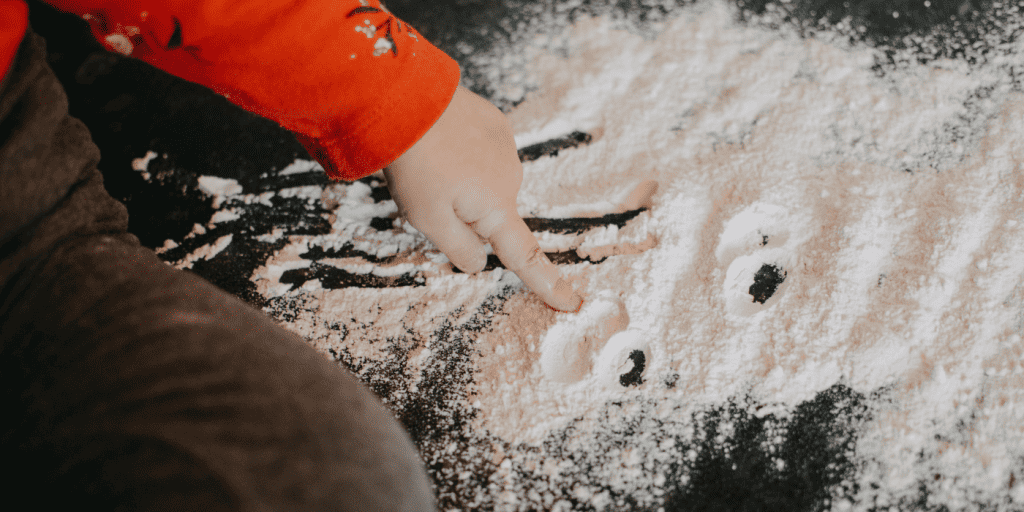
Scented cloud dough
Make cloud dough by mixing 8 parts flour to 1 part oil. Add a few drops of kid-safe essential oils like lavender or lemon for scent. Let your toddler enjoy the soft, pliable texture and sniff the scents.
Scented bath paint
Mix 1 cup cornstarch and 1 cup cold water. Separate into small containers and add liquid watercolor or food coloring. Add a drop or two of scented extracts. Use like bath fingerpaint – the color will show on tub walls but rinses away easily.
Scented play dough
Make homemade play dough and add a few drops of kid-safe essential oils to infuse scent. Roll dough into balls or press out with cookie cutters. Have your toddler feel the dough and sniff the aromas.
Frozen scented orbs
Place a drop of food coloring and a few drops of scented extract or essential oil in plastic Easter eggs. Add a bit of water, close, and freeze overnight. Let your toddler explore the colored icy orbs with their senses.
Scented cloud dough
Whip shaving cream and add kid-safe essential oils like lavender, lemon, or vanilla. Mix in cornstarch to make cloud dough. Let your toddler squish and form the soft, aromatic dough.
Scented sensory bags
Place dry materials like beans, rice, or beads in zipper bags. Add a few drops of essential oils and securely seal the bags. Allow your toddler to squish and smell the aromatic bags.
Scented sensory bins
Fill bins with materials like dried beans, pasta, or rice. Add a few drops of essential oil to infuse aroma. Allow your toddler to immerse their hands and sniff the scents as they play.
Frozen scented treats
Place sliced fruit and a drop of vanilla or almond extract in ice cube trays. Add water or juice and freeze. Pop out the cubes and let your toddler handle and lick the icy scented treats.
Taste Exploration Sensory Activities for 1 Year Olds:
Safe Taste Test: Offer bite-sized pieces of various fruits or soft foods, always under supervision to avoid choking hazards.
Edible sensory bin
Create a sensory bin with edible materials, such as cooked pasta or cereal. This is a great option for children who still put things in their mouth, as it eliminates choking hazards. Let them feel the different textures and shapes with their hands and mouth.
Spaghetti play
Cook some spaghetti and let your child play with it. The long noodles are fun to pick up and squish between fingers. You can add food coloring to make it more colorful and visually stimulating. Have your child practice scooping and pouring the noodles between containers.
Outdoor Sensory Exploration Activities for 1 Year Olds:
Sand Play: Let them play with sand, offering molds, cups, or just their hands.
Nature walk
Walk outside and let the child touch different natural textures, such as bark, leaves, or grass. Take your little one on a grassy nature walk with bare feet or bring some crunchy leaves inside for them to stomp on. Let them explore the different textures of grass, dirt, leaves, and more. Point out any interesting sights, sounds, and smells along the way.
Texture scavenger hunt
Hide different textured objects around the house for your child to find and explore. Use things like cotton balls, aluminum foil, feathers, pom poms, etc. Let them touch and describe each item.
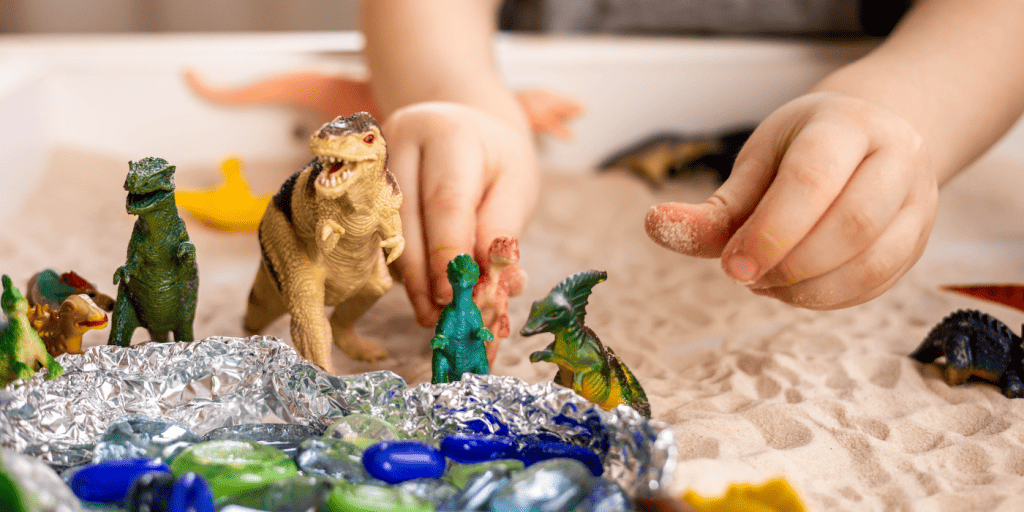
Handy Props Before You Start
We’ve gone out of our way to compile a fantastic list of DIY sensory activities that your little one will love, but that rely mainly on household items and ingredients. Here are a few items you might want to pick up if you are planning sensory play for one year olds.
Top pick

3 Pack Long Sleeve Toddler Aprons
An essential for any little one starting out with sensory play! These long sleeved bibs will protect clothing from paint, sand, water and more
Editor’s choice

50,000 Water Bead Jar
These colorful water beads swell and become squishy when added to water, making them a lovely addition to sensory play, under careful supervision.
Best value

8 Activity Trays
Whether you are using water, rice, play dough or sand, these colorful activity trays are really handy to present your child with a range of colors and textures
Why Should You Introduce Sensory Play for 1 Year Olds?
Introducing sensory play for 1 year olds can provide a variety of developmental advantages, making it a useful and pleasant experience for you and your child. It’s also so much fun to help your baby play with these sensory toys and activities!
Promotes Brain Development
Sensory play helps children learn about their surroundings and enhances their cognitive abilities. Children can develop their memory, attention, and problem-solving skills by engaging in sensory play.
Enhances Fine Motor Skill
Activities involving fine motor skills, such as manipulating small objects, can also help children develop hand strength and agility. This can be beneficial for tasks such as writing and drawing.
Encourages Language Development
Sensory play can help children learn new words and develop their understanding of language. By providing opportunities for children to describe their sensory experiences, they can expand their vocabulary and improve their communication skills.
Develops Creativity and Imagination
Sensory play encourages children to think creatively and develop new ways to use materials. This can help them develop their problem-solving skills and foster their imagination, which can be useful in many areas of life.
Sensory play can also help children develop empathy and understanding of others. Children can learn to take turns, share, and communicate effectively by engaging in sensory play with their peers. This can be beneficial for developing positive social relationships and emotional.
What Is The Perfect Way to Introduce Your Child to Sensory Play?
Sensory play for 1 year olds can be an enjoyable and engaging in supporting your child’s cognitive, physical, and emotional growth.
Start With Simple and Small Materials
Sensory play can also help toddlers develop empathy and understanding of others. Children can learn to take turns, share, and communicate effectively by engaging in sensory play with their peers.
This can aid in the formation of positive social relationships as well as emotional regulation. You can add various smells or textures to the materials to improve your child’s sensory experience, such as cinnamon to playdough or different kinds of rice for sensory bins. Add a few different animals for your little one to play with.
Follow your Child’s Lead
Allow your child to lead the activity and explore the items at their own pace. This will stimulate their curiosity and creativity. To promote your child’s exploration and discovery, you can also provide prompts or ask open-ended inquiries such as “What does this feel like?” or “What can you make with these materials??
If you hand over a bathtub painting stick baby will be quick to get playing!
Offer a Variety of Sensory Experiences
Provide a range of objects and activities that engage different senses, such as water play, sand play, or outdoor walks. This will help your child better understand their surroundings and sensory encounters.
You can also integrate sensory materials into daily activities, such as adding bubbles to bath time or dressing up in various textiles.
Create a Safe and Supervised Environment
Ascertain that the play area is safe and well-supervised and that the things are age-appropriate and clear of potential hazards.
It is critical to ensure that the play space is clear of possible hazards, such as small objects that can be a choking threat, and that human supervision is always provided.
Encourage Open-Ended Play
Allow your child to investigate the resources and engage in open-ended play rather than directing them toward a specific outcome or goal. This will aid in the development of their thoughts and creativity.
To encourage your child’s ingenuity and fantasy, you can also provide various tools and objects for sensory play, such as cups, utensils, and cookie cutters.
Engage in Sensory Play Together
Participate in your child’s sensory play by showing interest and enthusiasm in the items. This can help you and your child’s connection while offering opportunities for learning and growth.
You can demonstrate problem-solving skills and urge your kid to pose questions and make predictions while engaging in sensory play.
Encourage Messy Play
Sensory play for 1 year olds can be messy, but allowing your child to investigate without fear of making a mess is critical. You can provide a designated dirty play area and bibs or smocks to protect clothing. This can give your child more freedom to explore and examine.
To simplify cleaning, use a plastic tablecloth or shower curtain divider as a secure barrier beneath the play area or an easy-to-clean marked area, such as an outdoor space. You can also include your kid in the cleanup process to teach accountability and life skills.

